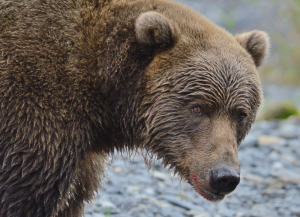The question I am most often asked about Kodiak bears is, “What is a Kodiak bear, and how does a Kodiak bear differ from an Alaskan brown bear or a grizzly bear?” This is a good question, and it does not have an easy answer.
From a taxonomic standpoint, all North American and Eurasian brown and grizzly bears are grouped into one species, Ursus arctos. The bears of the Kodiak Archipelago are further subdivided into the subspecies Ursus arctos middendorfi , and all other brown bears, including grizzly bears, are included in the subspecies Ursus arctos horibilis.
Before the advent of genetic testing, subspecies classifications were based on notable physical differences between individuals from two distinct populations of the same species. For example, a population of finches where the individuals have robust beaks suitable for cracking seeds might be considered a separate subspecies from a population of the same species that has thinner beaks more suitable for extracting insects from bark. It was reasoned that significant physical differences between two populations translates to genetic differences between these populations, but how much physical diversity is significant enough to declare a population a subspecies? In 1918, C. Hart Merriam divided North American brown and grizzly bears into eighty-six subspecies based on small physical differences between individuals in separate populations. Now scientists recognize only two subspecies.
What makes the Kodiak bear so different from all other brown bears that it rates its own subspecies classification? Probably the biggest difference between Kodiak bears and other brown bears is that Kodiak bears tend to grow larger and have bigger skulls. According to the Boone and Crockett Club record book, the definitive record book for hunting trophies, seventeen of the twenty largest brown bear skulls taken by hunters have come from Kodiak. Also, Kodiak bears are a geographically-isolated population, so it follows that Kodiak bears might be genetically different from all other brown bear populations.
This all made sense until the mid 1990’s when geneticists began studying genetic diversity across the North American range of brown bears. Their studies showed that while there is some genetic diversity between Kodiak bears and other brown-bear populations, this diversity is probably not significant enough to warrant the designation of a separate subspecies. In contrast, brown bears from Admiralty, Baranof, and Chichagof islands in southeastern Alaska show marked genetic differentiation from other Alaskan brown bear populations, and many researchers believe these bears should be considered a separate subspecies.
I guess all of this means that the more you know, the less you know, and there is no clear answer to why Kodiak bears are classified differently from other Alaskan brown bears. At the present time, Kodiak bears are considered a separate subspecies, but this classification may soon change as more genetic evidence is revealed.
What do you think? Should the classifications be changed? Should all brown and grizzly bears be considered one species with no subspecies designations?
For much more information on Kodiak bears visit my wildlife notebook.
